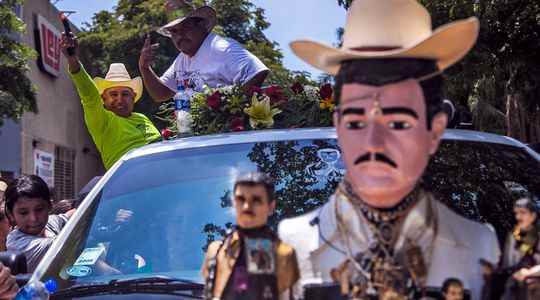“At 12, I was already a contract killer.” From the juvenile penitentiary to central Mexico, where he is imprisoned, Jacobo recounts his mafia career. All in all, a lookout, dealer and kidnapper, within the powerful Jalisco New Generation (CJNG) cartel, the repentant teenager consumed high doses of methamphetamines to endure the barbarity of his murders.
His chilling testimony depicts the criminal cycle that threatens hundreds of thousands of young Mexicans. On February 12, World Day Against the Use of Child Soldiers, organizations for the defense of minors sounded the alarm on the explosion in the recruitment of children and adolescents by drug cartels. Their fate often turns out to be tragic…
“I was in charge of torturing our rivals. We kidnapped them and beat them to extract information from them, then we dissolved their bodies in acid, dismembered them or riddled them with bullets.” It was a neighbor who recruited the teenager, now 17, to commit his first murder. “At first I didn’t want to, but when he offered me 30,000 pesos [NDLR : environ 1 300 euros]I did not hesitate.” A nice sum in a country where the minimum wage is capped at 7.50 euros a day. Misery, school failure, family violence … Jacobo’s life before resembles that of the 66 other young detainees interviewed by Reinserta, an organization for the defense of children who are victims of violence. Its director, Saskia Niño de Rivera, assures us that “children and adolescents have become the cannon fodder of the cartels”.
“It has become an addiction”
More than 1,000 minors were murdered in Mexico in 2021. And 21,000 perished between 2000 and 2019, according to the Network for Children’s Rights in Mexico (Redim). “The absence of official estimates on the number of children enlisted in organized crime has plunged this population into oblivion,” laments Tania Ramirez, its director, who estimates their number at more than 30,000.
Because they need new blood. The war in which the mafias are waging each other and against the government has caused more than 350,000 deaths in fifteen years. And “children are more discreet than adults, explains Saskia Niño de Rivera. They cost cartels less and justice is more lenient with them”. Mexican law provides for three to five years in prison for “child killers”. Their mafia backgrounds go through the surveillance of strategic drug trafficking areas, the sale of drugs in the streets and kidnappings, to then switch to torture and murder. Many are trained in the use of weapons in boot camps.
Between the role of victim and that of executioner, Susana quickly chose: “I wanted to kill”, says the teenager, whose mother was murdered by a competing cartel. She was 14 when she joined organized crime – the average age of “child killers”. “I had to pass tests, specifies the young girl from Monterrey, in northern Mexico. The first was to kill a man in front of a bar. I shot him four times, then I ran off with him. full adrenaline. I liked it, it became an addiction.”
The criminal careers of these young people are similar. Often it is a member of their family, a neighbor or a friend of the same age who puts them in the saddle: they are easy prey in a country where one in two Mexicans is poor. Tania Ramirez also evokes the consequences of a “narcoculture” glorifying traffickers: “These series on drug barons, rich and surrounded by pretty women, imprint the idea of a lifestyle in the heads of young people in trouble. opportunities, who feel they have nothing to lose.” The photos and videos of drug traffickers who parade with wads of dollars and machine guns driving sports cars are a hit on social networks, fertile ground for mafia recruitment.
The risk of a “lost generation”
Moreover, cartels innovate. Their touts are now tracking their future recruits on online video game platforms. Fans of Free Fire – a game that attracts millions of young people across the planet -, three Mexicans aged 11 to 14 were approached last year by a recruiter from the CJNG, directly on the messaging system integrated into the game. is the Secretary of State for Public Security, Ricardo Sóstenes Mejía Berdeja, who recounted their misadventure at the end of 2021, after their release by the authorities: “This story mixes the virtual and real worlds, he lamented. They had been recruited to monitor police radio frequencies, for a monthly salary of 16,000 pesos [NDLR : soit environ 700 euros].”
Three months later, the Minister of Public Security, Rosa Icela Rodriguez Velazquez, proposed to regulate the sale of video games glorifying violence. “A false solution, says Tania Ramirez. The phenomenon is above all linked to the social and educational abandonment of which these children are victims.”
According to Redim, more than 250,000 minors are “vulnerable” to the sirens of organized crime. Its leader therefore calls on the authorities to keep a precise register of young people enrolled in the cartels and to penalize their recruitment. “We must establish programs based on the prevention of juvenile delinquency and not only on repression,” she argues. The future of the country depends on it: “Once adults, these young people are very difficult to reintegrate, there is a risk of creating a lost generation.” The criminal spiral seems to have only two outcomes: prison or death. “I’m afraid for my life, says Jacobo. I know they’re going to try to kill me. I don’t want anyone to be sentenced to death” by organized crime.
